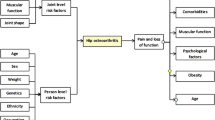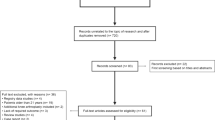Abstract
Objective
The relationship between metal wear debris, pseudotumor formation and metal hypersensitivity is complex and not completely understood. The purpose of this study was to assess the prevalence of pseudotumor formation in a consecutive series of metal-on-metal (MoM) total hip arthroplasty (THA) and to investigate its relationship to serum metal-ion levels and hypersensitivity to metal.
Methods
Forty-one patients (31 males), mean age 52 (28–68) years, with a total of 49 large-head MoM THA participated in a 5–7-year follow-up study. Patients underwent ultrasonography, serum metal-ion concentrations were measured, metal allergy and atopic dermatitis were evaluated, and the questionnaires of the Oxford Hip Score (OHS), Harris Hip Score (HHS) and the Short-Form Health Survey (SF-36) were completed.
Results
Pseudotumors were found in eight patients, but they were asymptomatic and their serum metal-ion levels were similar to those observed in patients with no pseudotumors (p > 0.36). The capsule-stem distance of mean 8.6 mm (SD 3.82, 95 % CI: 5.40–11.79) was wider (p = 0.02) in patients with pseudotumours than in patients without pseudotumors of mean 5.6 mm (SD 2.89, 95 % CI: 4.68–6.58). Positive patch test reactions were seen in three patients. Higher serum metal-ion levels of chromium and cobalt were significantly correlated with steeper cup inclination and smaller femoral head sizes, and were associated with female gender (p < 0.04).
Conclusion
We found no association between pseudotumor formation, serum metal-ion levels, metal patch test reactivity, and atopic dermatitis. However, clinicians should be aware of asymptomatic pseudotumors, and we advise further exploration into the mechanisms involved in the pathogenesis of pseudotumors.



Similar content being viewed by others
References
Bolland BJ, Culliford DJ, Langton DJ, Millington JP, Arden NK, Latham JM. High failure rates with a large-diameter hybrid metal-on-metal total hip replacement: clinical, radiological and retrieval analysis. J Bone Joint Surg Br. 2011;93(5):608–15.
Gill IP, Webb J, Sloan K, Beaver RJ. Corrosion at the neck-stem junction as a cause of metal ion release and pseudotumour formation. J Bone Joint Surg Br. 2012;94(7):895–900.
Malviya A, Ramaskandhan JR, Bowman R, Hashmi M, Holland JP, Kometa S, et al. What advantage is there to be gained using large modular metal-on-metal bearings in routine primary hip replacement? A preliminary report of a prospective randomised controlled trial. J Bone Joint Surg Br. 2011;93(12):1602–9.
Pandit H, Glyn-Jones S, McLardy-Smith P, Gundle R, Whitwell D, Gibbons CL, et al. Pseudotumours associated with metal-on-metal hip resurfacings. J Bone Joint Surg Br. 2008;90(7):847–51.
Goodman SB. Wear particles, periprosthetic osteolysis and the immune system. Biomaterials. 2007;28(34):5044–8.
Willert HG, Buchhorn GH, Fayyazi A, Flury R, Windler M, Koster G, et al. Metal-on-metal bearings and hypersensitivity in patients with artificial hip joints: a clinical and histomorphological study. J Bone Joint Surg Am. 2005;87(1):28–36.
Langton DJ, Jameson SS, Joyce TJ, Hallab NJ, Natu S, Nargol AV. Early failure of metal-on-metal bearings in hip resurfacing and large-diameter total hip replacement: a consequence of excess wear. J Bone Joint Surg Br. 2010;92(1):38–46.
Medicines and Healthcare products Regulatory Agency. Medical device alert: all metal-on-metal (MoM) hip replacements. 2010 (MDA/2010/03). London: MHPRA. 2010 [cited 2014 April 03]. Available from: http://www.mhra.gov.uk/home/groups/dts-bs/documents/medicaldevicealert/con079162.pdf
Lombardi Jr AV, Barrack RL, Berend KR, Cuckler JM, Jacobs JJ, Mont MA, et al. The Hip Society: algorithmic approach to diagnosis and management of metal-on-metal arthroplasty. J Bone Joint Surg Br. 2012;94(11 Suppl A):14–8.
Sofka CM, Potter HG, Adler RS, Pavlov H. Musculoskeletal imaging update: current applications of advanced imaging techniques to evaluate the early and long-term complications of patients with orthopedic implants. HSS J. 2006;2(1):73–7.
Bosker BH, Ettema HB, Boomsma MF, Kollen BJ, Maas M, Verheyen CC. High incidence of pseudotumour formation after large-diameter metal-on-metal total hip replacement: a prospective cohort study. J Bone Joint Surg Br. 2012;94(6):755–61.
Hart AJ, Satchithananda K, Liddle AD, Sabah SA, McRobbie D, Henckel J, et al. Pseudotumors in association with well-functioning metal-on-metal hip prostheses: a case-control study using three-dimensional computed tomography and magnetic resonance imaging. J Bone Joint Surg Am. 2012;94(4):317–25.
Chang EY, McAnally JL, Van Horne JR, Statum S, Wolfson T, Gamst A, et al. Metal-on-metal total hip arthroplasty: do symptoms correlate with MR imaging findings? Radiology. 2012;265(3):848–57.
Donell ST, Darrah C, Nolan JF, Wimhurst J, Toms A, Barker TH, et al. Early failure of the Ultima metal-on-metal total hip replacement in the presence of normal plain radiographs. J Bone Joint Surg Br. 2010;92(11):1501–8.
Matthies AK, Skinner JA, Osmani H, Henckel J, Hart AJ. Pseudotumors are common in well-positioned low-wearing metal-on-metal hips. Clin Orthop Relat Res. 2012;470(7):1895–906.
Thomas P, Braathen LR, Dorig M, Aubock J, Nestle F, Werfel T, et al. Increased metal allergy in patients with failed metal-on-metal hip arthroplasty and peri-implant T-lymphocytic inflammation. Allergy. 2009;64(8):1157–65.
Malajian D, Belsito DV. Cutaneous delayed-type hypersensitivity in patients with atopic dermatitis. J Am Acad Dermatol. 2013;69(2):232–7.
Biomet. M2a-Magnum large metal articulation: design rationale. Warsaw, IN: Biomet; 2009 [cited 2014 April 07]. Available from: http://www.biomet.com/campaign/trueAlternativeBearings/BOI03400MagnumDesignRationale.pdf
Murray DW, Fitzpatrick R, Rogers K, Pandit H, Beard DJ, Carr AJ, et al. The use of the Oxford hip and knee scores. J Bone Joint Surg Br. 2007;89(8):1010–4.
Harris WH. Traumatic arthritis of the hip after dislocation and acetabular fractures: treatment by mold arthroplasty—an end-result study using a new method of result evaluation. J Bone Joint Surg Am. 1969;51(4):737–55.
Bjorner JB, Thunedborg K, Kristensen TS, Modvig J, Bech P. The Danish SF-36 Health Survey: translation and preliminary validity studies. J Clin Epidemiol. 1998;51(11):991–9.
Craig JG. Ultrasound of the postoperative hip. Semin Musculoskelet Radiol. 2013;17(1):49–55.
Long SS, Surrey D, Nazarian LN. Common sonographic findings in the painful hip after hip arthroplasty. J Ultrasound Med. 2012;31(2):301–12.
Hailer NP, Bengtsson M, Lundberg C, Milbrink J. High metal ion levels after use of the ASR device correlate with development of pseudotumors and T cell activation. Clin Orthop Relat Res. 2014;472(3):953–61.
Cervini P, Hesley GK, Thompson RL, Sampathkumar P, Knudsen JM. Incidence of infectious complications after an ultrasound-guided intervention. AJR Am J Roentgenol. 2010;195(4):846–50.
Dramis A, Aldlyami E, Grimer RJ, Dunlop DJ, O’Connell N, Elliott T. What is the significance of a positive Propionibacterium acnes culture around a joint replacement? Int Orthop. 2009;33(3):829–33.
Becton Dickinson. Franklin Lakes, NJ: Becton Dickinson. 2013 [cited 2014 May 01]. http://www.bd.com/resource.aspx?IDX=10155
Thyssen JP, Linneberg A, Menne T, Nielsen NH, Johansen JD. The association between hand eczema and nickel allergy has weakened among young women in the general population following the Danish nickel regulation: results from two cross-sectional studies. Contact Dermatitis. 2009;61(6):342–8.
Hallab N, Merritt K, Jacobs JJ. Metal sensitivity in patients with orthopaedic implants. J Bone Joint Surg Am. 2001;83-A(3):428–36.
MacDonald SJ, Brodner W, Jacobs JJ. A consensus paper on metal ions in metal-on-metal hip arthroplasties. J Arthroplasty. 2004;19(8 Suppl 3):12–6.
Penny JO, Overgaard S. Serum chromium levels sampled with steel needle versus plastic IV cannula: does method matter? J Biomed Mater Res B Appl Biomater. 2010;92(1):1–4.
Papageorgiou I, Yin Z, Ladon D, Baird D, Lewis AC, Sood A, et al. Genotoxic effects of particles of surgical cobalt chrome alloy on human cells of different age in vitro. Mutat Res. 2007;619(1–2):45–58.
DeLee JG, Charnley J. Radiological demarcation of cemented sockets in total hip replacement. Clin Orthop Relat Res. 1976;121:20–32.
Gruen TA, McNeice GM, Amstutz HC. “Modes of failure” of cemented stem-type femoral components: a radiographic analysis of loosening. Clin Orthop Relat Res. 1979;141:17–27.
Brooker AF, Bowerman JW, Robinson RA, Riley Jr LH. Ectopic ossification following total hip replacement: incidence and a method of classification. J Bone Joint Surg Am. 1973;55(8):1629–32.
Altman DG. Practical statistics for medical research. London: Chapman and Hall, 2009. ISBN 9780412276309
Nishii T, Sakai T, Takao M, Yoshikawa H, Sugano N. Ultrasound screening of periarticular soft tissue abnormality around metal-on-metal bearings. J Arthroplasty. 2012;27(6):895–900.
Williams DH, Greidanus NV, Masri BA, Duncan CP, Garbuz DS. Prevalence of pseudotumor in asymptomatic patients after metal-on-metal hip arthroplasty. J Bone Joint Surg Am. 2011;93(23):2164–71.
Wynn-Jones H, Macnair R, Wimhurst J, Chirodian N, Derbyshire B, Toms A, et al. Silent soft tissue pathology is common with a modern metal-on-metal hip arthroplasty. Acta Orthop. 2011;82(3):301–7.
Siddiqui IA, Sabah SA, Satchithananda K, Lim AK, Henckel J, Skinner JA, et al. Cross-sectional imaging of the metal-on-metal hip prosthesis: the London ultrasound protocol. Clin Radiol. 2013;68(8):e472–8.
van Holsbeeck MT et al. Detection of infection in loosened hip prostheses: efficacy of sonography. AJR Am J Roentgenol. 1994;163:381–4.
Glyn-Jones S, Pandit H, Kwon YM, Doll H, Gill HS, Murray DW. Risk factors for inflammatory pseudotumour formation following hip resurfacing. J Bone Joint Surg Br. 2009;91(12):1566–74.
Thyssen JP, Linneberg A, Menne T, Johansen JD. The epidemiology of contact allergy in the general population: prevalence and main findings. Contact Dermatitis. 2007;57(5):287–99.
Thyssen JP, Linneberg A, Menne T, Nielsen NH, Johansen JD. Contact allergy to allergens of the TRUE-test (panels 1 and 2) has decreased modestly in the general population. Br J Dermatol. 2009;161(5):1124–9.
Thomas P, Stauner K, Schraml A, Mahler V, Banke IJ, Gollwitzer H, et al. Characteristics of 200 patients with suspected implant allergy compared to 100 symptom-free arthroplasty patients. Orthopade. 2013;42(8):607–13.
Jacobi-Gresser E, Huesker K, Schutt S. Genetic and immunological markers predict titanium implant failure: a retrospective study. Int J Oral Maxillofac Surg. 2013;42(4):537–43.
Langton DJ, Jameson SS, Joyce TJ, Webb J, Nargol AV. The effect of component size and orientation on the concentrations of metal ions after resurfacing arthroplasty of the hip. J Bone Joint Surg Br. 2008;90(9):1143–51.
de Haan R, Pattyn C, Gill HS, Murray DW, Campbell PA, De SK. Correlation between inclination of the acetabular component and metal ion levels in metal-on-metal hip resurfacing replacement. J Bone Joint Surg Br. 2008;90(10):1291–7.
Hart AJ, Buddhdev P, Winship P, Faria N, Powell JJ, Skinner JA. Cup inclination angle of greater than 50 degrees increases whole blood concentrations of cobalt and chromium ions after metal-on-metal hip resurfacing. Hip Int. 2008;18(3):212–9.
De HR, Campbell P, Reid S, Skipor AK, De SK. Metal ion levels in a triathlete with a metal-on-metal resurfacing arthroplasty of the hip. J Bone Joint Surg Br. 2007;89(4):538–41.
Pattyn CA, Lauwagie SN, Verdonk RC. Whole blood metal ion concentrations in correlation with activity level in three different metal-on-metal bearings. J Arthroplasty. 2011;26(1):58–64.
Acknowledgements
We thank Lone Løvgren, Rikke Mørup, and Inger Krog-Mikkelsen for their help with arranging the 5–7-year follow-up.
Authors’ contributions
All authors made substantive intellectual contributions to this study to qualify as authors. MHH, KS, MS, IM, JSS, LB, and JPT were involved in the study hypothesis and follow-up examinations. MHH performed the data analyses and wrote the initial manuscript. MS, IM, KS, JSS, LB, and JPT helped revise it. All authors read and approved the final manuscript.
Author information
Authors and Affiliations
Corresponding author
Ethics declarations
Competing interests
The authors declare that they have no competing interests.
Rights and permissions
About this article
Cite this article
Hjorth, M.H., Stilling, M., Soballe, K. et al. No association between pseudotumors, high serum metal-ion levels and metal hypersensitivity in large-head metal-on-metal total hip arthroplasty at 5–7-year follow-up. Skeletal Radiol 45, 115–125 (2016). https://doi.org/10.1007/s00256-015-2264-8
Received:
Revised:
Accepted:
Published:
Issue Date:
DOI: https://doi.org/10.1007/s00256-015-2264-8




